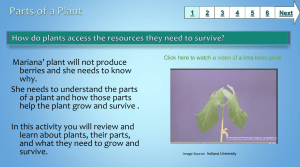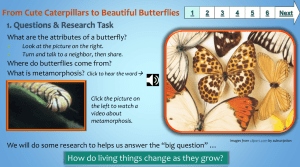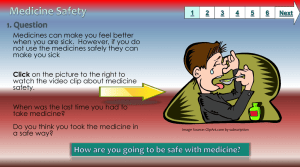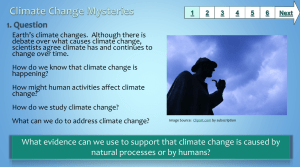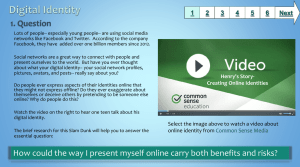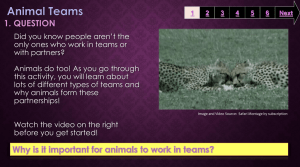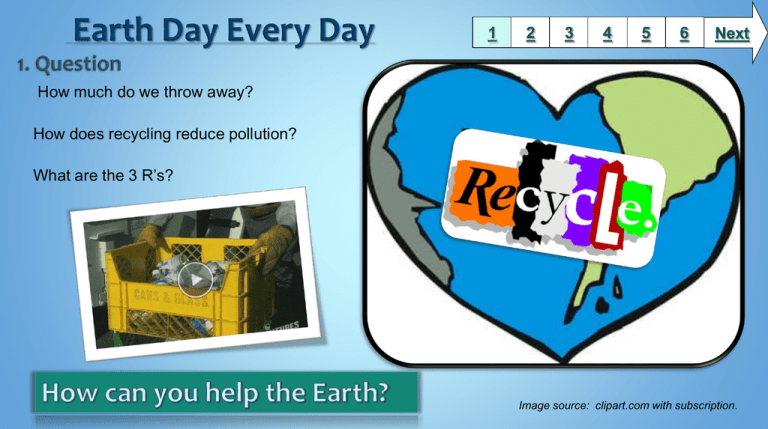
1
2
3
4
5
6
Next
How much do we throw away?
How does recycling reduce pollution?
What are the 3 R’s?
Image source: clipart.com with subscription.
1
1. How can we reduce trash?
2
3
4
5
6
Next
2. Reduce, Reuse, Recycle!
*NOTE: Go to the BCPS Database page and click on BrainPOP Jr.,
then return to this slide and click on the video link below.
3. Practice what you heard?
Video and images courtesy of Scholastic.
Click the picture to
the right to review
vocabulary.
Video and images courtesy of BrainPopJr.
1
1. With a partner, complete
the following handout.
2
3
4
5
6
Next
2. On your own, complete the
following trash sorting activity.
(You may only play 2 times
before moving on).
Image source: clipart.com with subscription.
Game and images courtesy of Scholastic.
1
2
3
4
5
6
Next
1. Click the picture to the right to complete the
Talk About It activity. You are to draw one way
to help the earth.
Images source:
BrainPopJr.
Final Assessment
With a partner you will create a PSA commercial using a flip-camera.
1. One partner records, while the other partner speaks. Switch so you each do both
jobs.
2. State three ways to HELP the Earth and why it is important.
3. Make sure you look at the camera and speak loudly & clearly.
Click here for Scoring Rubric
↓
1
1. Click the picture
at right for Earth
Day story, activity,
and song.
2. BrainPOP Jr.- Reuse Drawing
Activity
2
3
4
5
6
Next
4. Scholastic Earth Day Celebration
read along
5.
Scholastic We Did It read along
3. Sesame StreetDon’t Waste It
Day Playlist
Video and images courtesy of BrainPopJr, Scholastic, Starfall, and Sesamestreet
1
BCPS Curriculum
Language and Literacy
Classifies information
- compares and categorizes
Speaks for a variety of purposes
- engages in meaningful conversation
- uses appropriate languages in order to inform, persuade, or to
express personal ideas.
Uses pictures and print to perform a task
Science
Observes and describes the characteristics of living things
- identifies the basic needs of living things
Common Core State Standards
Speaking and Listening : 2. Confirm understanding of text read aloud or information presented
orally or through other media by asking and answering questions about key details and requesting
clarification if something is not understood.
Speaking and Listening : 6. Speak audibly and express thoughts, feelings, and ideas clearly.
Writing: 7. Conduct short as well as more sustained research projects based on focused questions,
demonstrating understanding of the subject under investigation.
Standards for the 21st Century Learner
1.1.6 Read, view, and listen for information presented in any format (e.g. textual, visual, media,
digital) in order to make inferences and gather meaning.
2.1.3 Use strategies to draw conclusions from information and apply knowledge to curricular areas,
real-world situations, and further investigations.
Maryland Technology Literacy Standards for Students
3.0 : Use a variety of technologies for learning and collaboration.
2
3
4
5
6
Time Frame:
2-4 Class periods will be required to complete this activity.
Green =challenging material- self paced with little support
Yellow = Easy material- independent level, some may need
some help.
Red = For Everyone
Learning Preferences- The learning preferences provided are
mainly visual and auditory. Due to the age of the
audience, these were the best way to present the
material.
Notes to the teacher:
This Slam Dunk is written for primary students , mainly
Kindergarteners. Although, it can be used for 1st and 2nd
graders as well. Being able to express personal thoughts and
explain their reasoning is a very important skill to accomplish
early in school. Also, having students aware of current events
is important as well.
You may need to login the first time the BrainPop videos are
launched.
Last update: December 2011,, revised July 2014
Created by Erin McElwee Kindergarten teacher and Library Cohort Summer Intern
BCPS Research Module or Slam Dunk Model, Copyright 2013, Baltimore County Public Schools, MD, all rights reserved. The models may be used for educational, non-profit school use
only. All other uses, transmissions, and duplications are prohibited unless permission is granted expressly. This lesson is based on Jamie McKenzie’s Slam Dunk Lesson module available
at http://fno.org/sept02/slamdunk.html.

